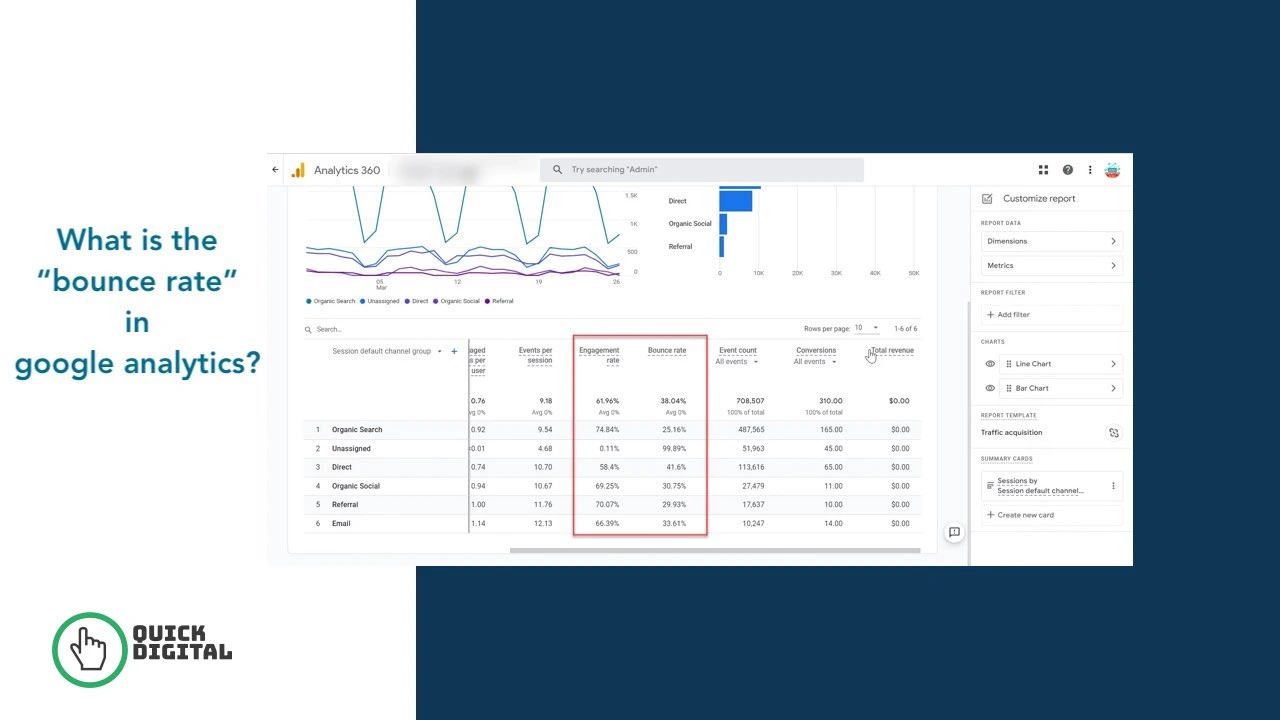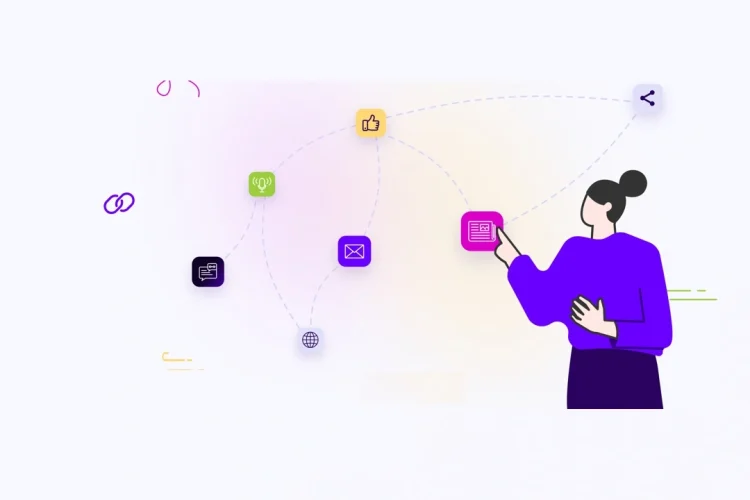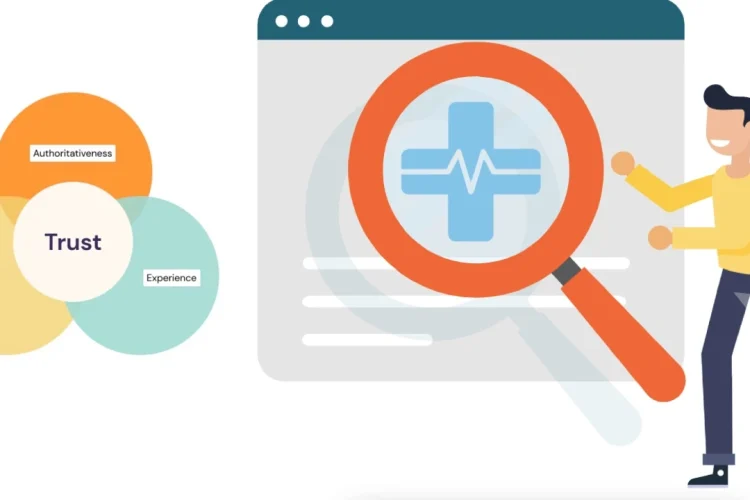
What is the bounce rate?
What is bounce rate in google Analytics, is the bounce rate calculated in percentage of single page visits (or sessions) when a user triggers only one request from the Google Analytics server, such as one page view, and exits without triggering any other request from the server. (Another pageview, a goal completion, etc.)
Your website’s bounce rate is simply the number of single-page sessions (bounces) divided by the total number of sessions.
Since there are no engagement hits after the initial pageview that would allow Google bounce rate Analytics to track the length of the session, “Bounces” will lower your average session duration, as single-page views have a session duration of 0 seconds.
How does Google Analytics calculate bounce rate?
There is no hard and fast rule to define what a good bounce rate is. It differs by industry, type of webpage, etc. In fact, per a study by KISSmetrics, there are huge variations between average bounce rates for different industries (as shown below).
As you can see, retail sites have a low average bounce rate, probably because people check out several products before they decide to buy or leave. And, content-heavy websites have high bounce rates because they often rank for irrelevant keywords as well.
At SpyFu, our homepage has a low bounce rate and this is usually the case with most home pages if they are built correctly.
what is a good bounce rate?
So, there is no clear answer to the question of “what is a good bounce rate?” But you can learn what a bad bounce rate is.
Anything higher than 70% is consider a bad bounce rate because too many of your website visitors are leaving too quickly. This means that your CTAs are not working or your content is not good enough to encourage the viewers to stay, and of course, this can impact your conversion rates. However, there are exceptions to this, as for some pages, like a contact page, having a high bounce rate or a high exit rate could be good because the intend action is complete on that page itself.
Similarly, having an extremely low bounce rate is not always good. In fact, a bounce rate lower than 20% is not a good bounce rate because it, more often than not, points to some other problem. After all, if something is too good to be true, it probably isn’t.
A bounce rate lower than 20% could be because your analytics is not working properly or maybe your website is forcing viewers to go through some gateway page before they leave. In any case, if your bounce rate is surprisingly low, just ensure that it is not because of any other reasons except that people actually like your site that much.
How to interpret the bounce rate metric?
Learn the truth about bounce rate and why it’s not as straightforward as you might think. Also, learn how to conduct a bounce rate audit and improve website engagement.
how to check bounce rate of website.
Just navigate to your behavior reports. Click on “Site Content” and then “Landing Pages.” You’ll immediately see the average, site-wide bounce rate.
Many people talk about how important it is to have a “low bounce rate.”
But bounce rate is one of the most misunderstood metrics in digital marketing. Look at bounce rates on your website for a particular time period.
Dig deep into different segments to see if one particular segment is higher than others. Maybe there is a particular change you made to the website that had an influence on bounce rate.
User intent/behavior
It’s important to keep track of where users are coming from when they visit your site.
Are they coming through your email newsletter? Organic search? Paid ads on social? If the bounce rate is especially high for one of these sources, it could mean that something at the source—like your ad copy—needs to be tweaked to better convey your message. If that Facebook ad doesn’t prepare people for what they’ll actually see on your page, they’ll probably end up leaving.
Do your best to eliminate all of the aspects of your site that might distract or annoy your users.
If someone gets hit with a chatbot, a full-screen popup ad for your newsletter, and a popup coupon offer in quick succession, they’ll probably run. Be mindful of the popups and ads you use, and incorporate them seamlessly into your site instead of throwing them in the user’s face.
Also make sure you examine your site’s keywords and how they rank. Are you using the right keywords for your industry to bring in the right people at the right time?
If you’re selling marketing automation software, you want people coming to your site who already know what that is and can better understand the benefits your product offers. You don’t want to draw in someone who’s just discovering the concept. If that person finds you and clicks through to your site, they might become overwhelmed and leave very quickly, which will affect your site’s overall bounce rate.
In short, make sure your page is ranking for keywords that reflect its content. Try grouping your site’s pages by subject and seeing what topics they fit into, then making sure they’re attracting the right users.
Type of website
While it’s clear there are different types of websites in the world, we’ve picked the most common categories to give you a general idea. These types of websites include blogs, corporate, ecommerce, portfolio or photo-sharing, crowdfunding, news/magazine, social media, TV or video streaming, educational, portal, and a wiki or community forum.
Type of landing page
Landing pages typically fall into three main categories, each with its own unique strengths and strategies: splash pages, squeeze pages, and sales pages. A single marketing campaign may include one or multiple types of landing pages, depending on the calls to action that move a visitor forward.
Quality of the landing page
All three search engines have revealed that landing page quality is a factor in determining Quality Score. Landing page quality generally refers to whether or not the page contains relevant and original content and the navigability of the site. In the case of MSN, they have reveale that ads with landing pages that don’t contain the keyword may be declined altogether
Type of content
Content is the currency of the internet, and there are hundreds of types that brands can focus on creating to engage audiences, reach new target markets, provide value to customers, and entice new prospects. Blogs, Listicles, Ebooks, Infographics, Video, How-to Guides and Case Studies to name a few.
Type of Industry
In economics and economic geography, refers to the production of an economic good or service within an economy.
- Agriculture
- Manufacturing
- Service industries
Quality of Traffic
All internet traffic is create equal. While traffic quantity is obviously important, traffic quality is what gets you customers. Both quantity and quality of traffic are important for a high-performing website. High quantities of traffic mean brand awareness and online visibility. High-quality traffic, however, can mean a higher ratio of conversions and sales.
Type of Marketing channel
Marketing channel refers to the means through which the physical distribution of goods takes place from the manufacturer to the customers, either directly or through intermediaries. The manufacturer can also adopt Multi-Channel marketing if he finds it suitable for his product and the business.
Visitor Type
Naturally you want people who visit your website to buy from your company. But the truth is, most of your visitors aren’t ready to buy. And if you focus all your marketing on the small portion that is ready to buy right at the moment they visit your site, you’re leaving hundreds of opportunities behind. Beyond any other single marketing asset, your website needs the breadth and depth to attract and retain interest from visitors at every stage in their buying process.
Website visitors generally fall into three categories. You’ll increase your long-term business results if you tailor your content so that it speaks to each group’s differing needs.
1. People who are ready to buy.
2. People who are interested in what you have to offer, but are not yet ready to buy.
3. People who are not (yet) interested in your products or services.
Device Type
Our device detection platform is powered by an immense device database that contains thousands of web-enabled devices. To build and maintain the database, we follow all new product releases focusing on internet connectivity. While these ‘connected’ devices used to be mainly PCs, today this category is much more diverse and runs the gamut from mobile phones, to tablets and desktops.
Today any device can be web-enabled once equipped with appropriate connectivity (WiFi, 3G, 4G). The expansion of Android, and the lowered cost of hardware components, has made bringing connectivity to a device even easier and cheaper.
- 1. Desktop computers
- 2. Mobile phones
- 3. Tablets
- 4. Smart TVs
- 5. Game Consoles
- 6. Wristwatches
- 7. Ebook readers
- 8. Digital cameras
- 9. Cars
- 10. Home appliances
- 11. Smart glasses
How to analyze and report the bounce rate metric?
“Bounce rate is one-page sessions divided by all sessions, or the percentage of all sessions on your site where users only looked at a single page and triggered only a single request to the Analytics server.”
For example, let’s say there were a total of 100 sessions on your website, of which 75 were different single-page sessions. What is the bounce rate on your website?
In this case, 75% of people who visited it popped up after a single need, so the bounce rate is 75%.
Let’s talk about why you should care about this calculation.
To put it simply, and high indicates the bounce rates that are accustomed to finding that problem with your site. In particular, a high rejection rate may indicate that:
- People are being robbed of the design of your website
- The content does not meet visited expectations
- The offer on your site is not that good
It should be noted that a high bounce rate is not always a warning sign. There are certain industries and websites where a high bounce rate is unavoidable and should not be looked at as a cause for concern.
That said, unless your site falls into the category, stock market and highest advancement be you to analyze the page, identify the cause of the problem and figure out how to solve it.
It is also worth noting when it can be an SEO benefit to improve your bounce rates. Of course, Google’s algorithms keep theirs secret, so we can not know this for sure, but there will be no oversupply of the favored sites with low bounce rates.
Why is bounce rate an important metric to consider?
It measures visitor engagement, or lack thereof, when the bounce rate is high. From a business perspective, it provides an index of return and cost-effectiveness for your efforts. Bounce visitors can be seen to cost you money!
A high bounce rate is a sign that your content is not targeted to your browser’s wants and needs. If you look at bounce rate in Google Analytics you will see a percentage. For example, if your average bounce rate is 75%, then 75% of people who come to your site will only see the page they entered.
Does a bounce count as a session?
Basically, if GA shows 100 sessions per month, and 80% bounce rate – does this mean that 80 people bounced (or in other words, engaged in a one-page session) while 20 people saw more than one page; or does it mean that 400 people bounced and 100 people continued to multi-page sessions.
It means that 80% of the visitors in the selected time frame failed to visit more then one page.
100 visitors, 80% bounce rate = 20 visitors made it past the first page they arrived at.
Does bounce rate include scrolling?
The bounce rate includes scrolling, as it is specific to contacts who only visit that page and then leave your site. As long as the tracking code has been fire on the web page and visitors leave the site from that page, they will be include in this price.
Does Bounce Rate Affect SEO?
One of the most underestimated and under-valued metrics of any website’s SEO campaign is the site’s “bounce rate”. What does bounce rate mean and why is it important? That’s a great question and one that Google does not help us much with.
First, we should define the word “bounce” in SEO terms. I believe a “bounce” is when a searcher uses Google to find your site via specific keyword searches and, upon clicking your Google listing for said keywords, immediately (or within a specific time frame that is not defined by Google) clicks the back ”button on his / her browser, thus taking the searcher back to the Google listings.
I realize this might sound a little complicated, but it is fairly simple when you consider how search engines work and why a bounce might affect the rankings of a website.
Contact us for bounce rate consultation!
We’d like to learn about you, your organization, and how we can transform your website into an engaging online experience and powerful revenue generator. Please explore our portfolio of case studies, learn more about our team, process, and social impact – and find our service offerings here.





